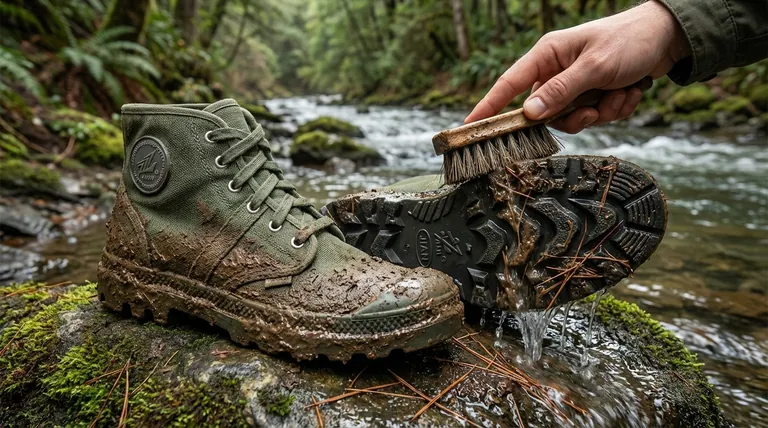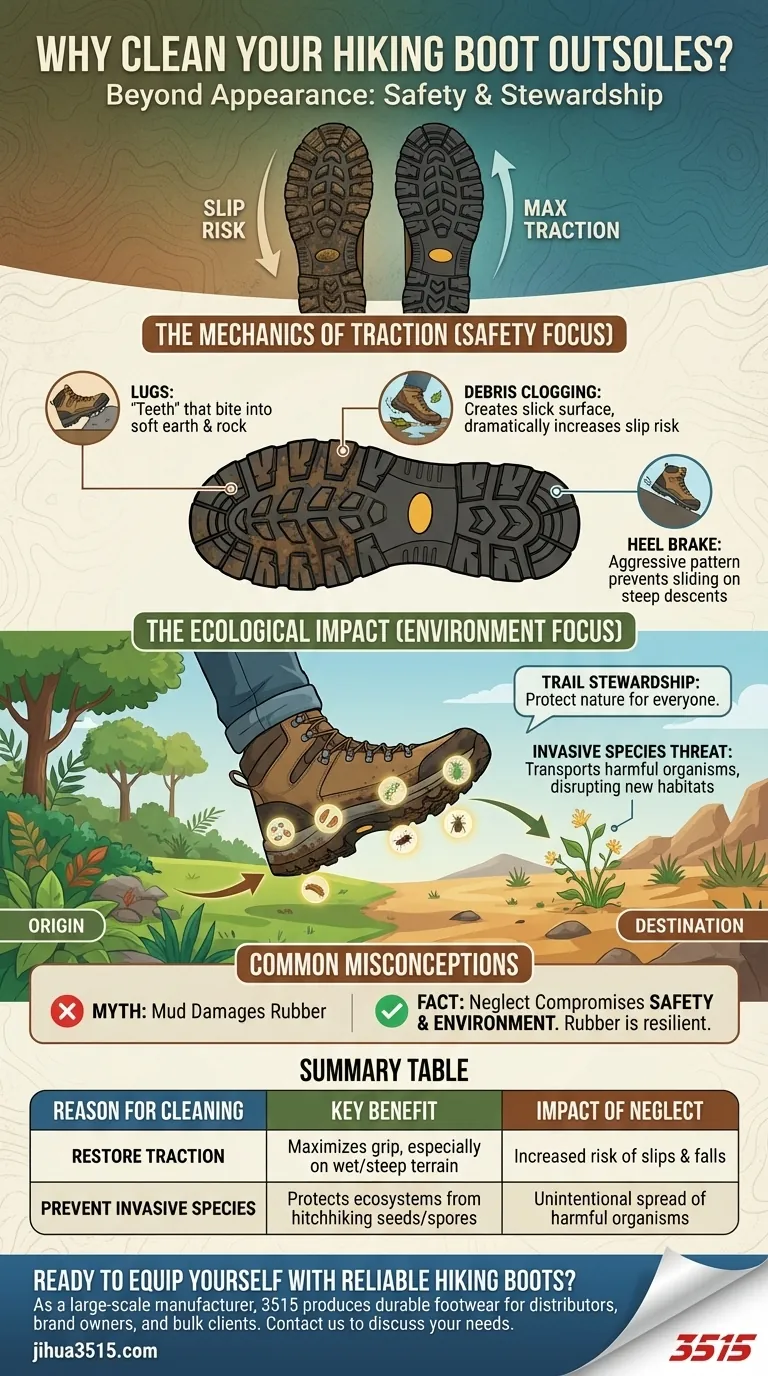Cleaning your hiking boot outsoles is about much more than appearance. It is a critical maintenance step for two primary reasons: restoring maximum traction for your safety and preventing the spread of invasive species between ecosystems. When the specialized lugs on your boots are clogged with mud and debris, their ability to grip the terrain is severely compromised.
While caked-on mud will not cause the rubber outsole to deteriorate, ignoring it compromises your grip on the trail and makes you an unintentional carrier of potentially harmful organisms. Proper cleaning is a simple act of both performance maintenance and environmental stewardship.

The Mechanics of Traction: Why a Clean Outsole Grips Better
To understand the importance of cleaning, you first have to understand how your boot's outsole is engineered to keep you stable on the trail.
The Outsole's Purpose
The outsole is the durable rubber layer at the bottom of your boot. Its entire design is focused on providing traction and protecting your foot from the ground.
The Critical Role of Lugs
The deep, patterned indentations on your outsole are called lugs. Think of them as the teeth of your boot or the tread on a high-performance tire. They are designed to bite into soft earth, grip uneven rock, and channel water away to maintain contact with the surface.
How Debris Disables Grip
When mud, small pebbles, and wet leaves pack into the spaces between the lugs, they create a single, smooth surface. This effectively turns your high-traction outsole into a flat, slick bottom, dramatically increasing the risk of a slip or fall, especially on wet or steep terrain.
The Function of the Heel Brake
Many hiking boots feature a distinct "heel brake"—an aggressive, forward-facing lug pattern on the heel. This feature is specifically designed to prevent you from sliding during steep descents. If this area is clogged with debris, its braking ability is rendered almost useless.
The Ecological Impact of a Dirty Boot
Your responsibility as a hiker extends beyond your personal safety. The condition of your outsoles has a direct impact on the environments you explore.
Your Boots as Transportation
Think of your dirty boot soles as unintended transportation for hitchhikers. Every time you walk, you pick up seeds, plant fragments, microscopic insects, and fungal spores from the local environment.
The Threat of Invasive Species
When you hike in one area and then drive to another without cleaning your boots, you risk introducing these hitchhikers into a new ecosystem. A non-native seed or spore can grow into an invasive species, outcompeting native plants and disrupting the delicate local habitat.
A Matter of Trail Stewardship
Cleaning your boots is a fundamental principle of responsible hiking, akin to the "Leave No Trace" ethic. It is a simple but powerful action you can take to protect the natural beauty of the trails for everyone.
Understanding the Trade-offs and Misconceptions
It's important to be precise about what happens when you don't clean your outsoles, as there are common misunderstandings.
Misconception: Mud Damages the Rubber
The durable rubber compounds used in modern outsoles are not susceptible to damage from dried mud. You do not need to clean your soles to prevent them from rotting or cracking; the material is far too resilient for that.
The Real Cost of Neglect: Safety and Environment
The true trade-off for not cleaning isn't damage to your gear—it's a direct compromise of your safety and environmental responsibility. You are choosing to hike with less traction and to potentially carry invasive species.
When to Prioritize Cleaning
A quick knock or scrape to remove large clumps of mud after every hike is a good habit. A more thorough scrubbing becomes essential when you plan to hike in a completely different park, state, or ecological region.
Making the Right Choice for Your Hike
Your approach to cleaning can be tailored to your immediate goal, but the underlying principles remain the same.
- If your primary focus is personal safety and performance: Always scrape off caked mud and debris after a hike to ensure your lugs and heel brake are fully exposed for maximum traction on your next outing.
- If your primary focus is environmental responsibility: Thoroughly scrub and inspect your outsoles with a brush and water before traveling to a new park or hiking in a different ecological region.
A clean outsole is the foundation of a safe, responsible, and confident presence on the trail.
Summary Table:
| Reason for Cleaning | Key Benefit | Impact of Neglect |
|---|---|---|
| Restore Traction | Maximizes grip on trails, especially on wet or steep terrain. | Increased risk of slips and falls due to clogged lugs. |
| Prevent Invasive Species | Protects ecosystems by removing seeds, spores, and insects. | Unintentional spread of harmful organisms to new areas. |
Ready to equip yourself with reliable hiking boots? As a large-scale manufacturer, 3515 produces a comprehensive range of durable footwear for distributors, brand owners, and bulk clients. Our production capabilities encompass all types of hiking boots and shoes designed for performance and longevity. Contact us today to discuss your footwear needs and discover how we can support your business with high-quality, reliable products.
Visual Guide

Related Products
- Factory-Direct Wholesale Canvas Boots with High-Traction Rubber Soles
- Wholesale High-Traction Camo Boots - Custom Manufacturer for Brands
- Premium Wholesale Waterproof Safety Boots High Performance Protection for Industrial Markets
- Wholesale Safety Footwear Manufacturer for Bulk & Custom OEM Orders
- Factory Direct Wholesale Rain Boots Durable Waterproof & Fully Customizable
People Also Ask
- Why is rubber commonly used for non-slip soles? The Science of Superior Grip
- What types of work environments are hiker-style rubber outsoles best for? Ideal for Outdoor & Industrial Safety
- Why is rubber a popular material for shoe soles? Unbeatable Grip, Durability & Value
- Why are rubber soles beneficial in cold-weather boots? Superior Traction & Waterproofing
- What are the advantages of rubber soles in safety boots? Unbeatable Grip & Durability



















